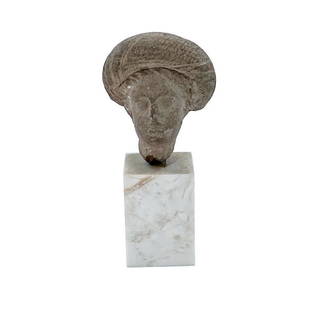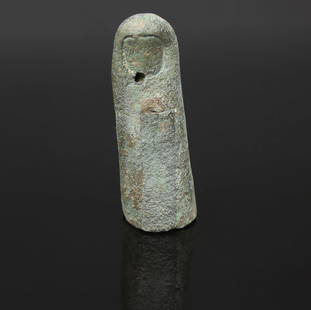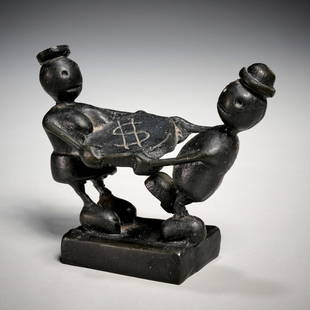
Etruscan Terracotta Votive Phallus
Similar Sale History
View More Items in Statues & StatuettesRelated Statues & Statuettes
More Items in Ancient Greek & Roman Statues & Statuettes
View MoreRecommended Sculptures & Carvings
View More




Item Details
Description
Ancient Mediterranean, central Italy, Etruria, ca. 4th to 1st century BCE. A fascinating pottery phallus likely from a sanctuary votive deposit in Etruria. Such terracotta male genitalia may have been given either as a request or as an offering of thanks for healing related to the common condition of phimosis or for the onset of puberty. The practice of creating and dedicating anatomical renderings as votive offerings was widespread in ancient Etruria and Latium, evident from the seventh century BCE onward and most popular in the Hellenistic period (3rd?1st centuries BCE). A variety of body parts were depicted, from whole and half heads, to arms and legs, hands and feet, and fingers and toes, to eyes and ears, female and male genitalia, and breasts, to internal organs, including the uterus, heart, and bladder. Anatomical votives have been found exclusively at sanctuaries, spread over some 300 sites in the Etrusco-Italic region. Size: 3.1" L x 3.1" W x 4.2" H (7.9 cm x 7.9 cm x 10.7 cm); 6.7" H (17 cm) on included custom stand.
Because very few Etruscan anatomical votives include dedicatory inscriptions, it is uncertain whether they were offered to a god according to a vow (ex-voto) to give thanks after a wish had been fulfilled or to encourage the god?s participation in granting a request or prayer. In either case, votives appear to have been offered by individuals as part of a ritual, with considerable numbers of such votives found at or near sanctuary altars and most found grouped in secondary deposits (presumably to make room for new offerings). In the absence of dedicatory inscriptions, the meaning of these anatomical votives is debated. They may have been given more literally for the protection or cure of certain body parts and their capabilities, or they may have represented something more figurative (e.g., ears signifying being heard by the god, eyes as being seen, or hands expressing persistent prayer).
Provenance: private New York, New York, USA collection; ex-private San Francisco, California, USA collection, acquired in Italy in the 1980s
All items legal to buy/sell under U.S. Statute covering cultural patrimony Code 2600, CHAPTER 14, and are guaranteed to be as described or your money back.
A Certificate of Authenticity will accompany all winning bids.
We ship worldwide to most countries and handle all shipping in-house for your convenience.
#184733
Because very few Etruscan anatomical votives include dedicatory inscriptions, it is uncertain whether they were offered to a god according to a vow (ex-voto) to give thanks after a wish had been fulfilled or to encourage the god?s participation in granting a request or prayer. In either case, votives appear to have been offered by individuals as part of a ritual, with considerable numbers of such votives found at or near sanctuary altars and most found grouped in secondary deposits (presumably to make room for new offerings). In the absence of dedicatory inscriptions, the meaning of these anatomical votives is debated. They may have been given more literally for the protection or cure of certain body parts and their capabilities, or they may have represented something more figurative (e.g., ears signifying being heard by the god, eyes as being seen, or hands expressing persistent prayer).
Provenance: private New York, New York, USA collection; ex-private San Francisco, California, USA collection, acquired in Italy in the 1980s
All items legal to buy/sell under U.S. Statute covering cultural patrimony Code 2600, CHAPTER 14, and are guaranteed to be as described or your money back.
A Certificate of Authenticity will accompany all winning bids.
We ship worldwide to most countries and handle all shipping in-house for your convenience.
#184733
Condition
Some chipping to upper corners and light surface wear as shown, but otherwise intact and in overall excellent condition with earthen deposits throughout. Small spot of red pigment on top periphery.
Buyer's Premium
- 27.5%
Etruscan Terracotta Votive Phallus
Estimate $1,000 - $1,500
8 bidders are watching this item.
Shipping & Pickup Options
Item located in Louisville, CO, usSee Policy for Shipping
Payment
Accepts seamless payments through LiveAuctioneers

Auction Curated By

Owner/Executive Director, Antiquities & Pre-Columbian Art

PhD. Art History, Director, Fine & Visual Arts
TOP






























































